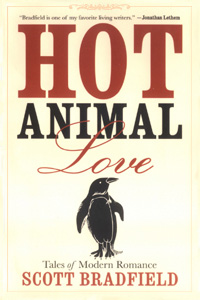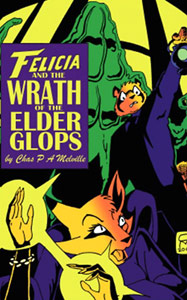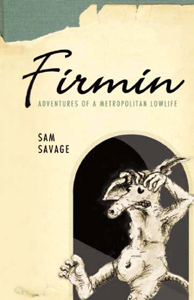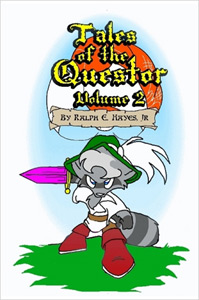
Cover of the color edition |
|
|
| Author: |
Ralph E. Hayes, Jr. |
| Publisher: |
RHJunior Productions (South Charleston, WV)/Lulu.com (Raleigh, NC), Aug 2006 |
|
| Title: |
Tales of the Questor, Vol. 2 |
| ISBN: |
— |
|
Trade Paperback, [1 +] 169 pages, USD $39.99 |
|
| Title: |
Tales of the Questor, Vol. 2 B&W |
| ISBN: |
— |
|
Trade Paperback, [1 +] 169 pages, USD $15.99 |
|
|
This is one of those reviews that seems rather redundant. If you are a fan of Ralph Hayes’ full-page, full-color Tales of the Questor Internet comic strip, you already know that volume 2 is out and you have bought it. If you are not, you should start with volume 1. Read the review of it in Anthro #2 in the Archive or Index.
As with volume 1, the full-color edition is recommended over the black-&-white edition because the color is so spectacular. Instead of saying, “$39.99 for a book?”, you will ask, “How can they publish so much color for only $39.99?” It is well worth the price.
Volume 2 starts right after the end of volume 1. It is smaller (169 pages versus 223 pages) because that is where the story breaks into distinct chapters. Where volume 1 ends with the clear conclusion of an episode, volume 2 ends with a big ‘TO BE CONTINUED’ leading to what will be Quentyn’s biggest adventure yet. Yet the break is encouraging, not frustrating, to readers. See for yourself.
Quentyn, son of the farmer Quinn, is a young questor in the isolated raccoon land of the Seven Villages. He is the only questor they have left; an embarrassing throwback, many think, to more primitive days and no longer necessary. As Quentin’s adventures have shown, a questor is still very necessary whether the more refined social classes want to admit it or not.
Volume 2 contains four distinct stories (comprising pages 226, April 10, 2005 to 397, July 12, 2006 on Hayes’ Tales of the Questor website). Quentyn, raised in the small farming community of Freeman Downs, becomes involved with the politics and the slum street gangs of the capital city, Sanctuary, in the first and longest story. Back home, he has to redeem his reputation and reestablish his authority to act without the constraints of bureaucracy in the second story. The third is an interlude without Quentyn, featuring his childhood friends Kestrel and Fennel. The fourth story is really a setup for the adventure that will make Quentyn the first Racconan to venture beyond the Seven Villages into the outside world in almost a century, leading to volume 3.
These cannot all be called ‘complete stories’. The first and second are, but the fourth is really a long prelude to the next volume. The interlude with Kes and Fen is—strangely incomplete, ending abruptly and unsatisfyingly. Deliberately so? I confess that I can’t figure it out. Is this supposed to show that Quentyn’s friends cannot succeed without him? Or that there are some supernatural mysteries that cannot be solved by a questor’s action-oriented methods? Was this a story that Hayes broke off because it was not working out, or is it a setup which will be returned to in one of Quentyn’s future adventures? In any case, it adds to the personalities of Kestrel and Fennel, improving the supporting cast.
Hayes has already shown that Quentyn is growing emotionally and in expertise. His adventures in volume 1 featured straightforward physical or supernatural adversaries which Quentyn could defeat by hacking & slashing with his magic sword. Those in volume 2 require more psychological finesse. Quentyn must learn diplomacy and how to fight against political enemies, whether he wants to get involved in dirty politics or not. A future story could take Quentyn into supernatural realms where his friends cannot go.
Almost more intriguing than Quentyn’s adventures is the background of the Seven Villages, the land of the Rac Cona Daimh. Hayes has been dropping tidbits of its history and politics into the ongoing story. We learn in this volume that Freeman Downs, the most recent and smallest of the villages, was settled when “most of the families living here now moved here after Silver Springs collapsed.” (pg. 151) There is also a mention of a ‘scarlet plague’ that killed many of Freeman Downs’ founders. Presumably this history is well-known to all the Rac Cona Daimh, but it sounds like it would be fascinating to we readers. Hayes is adept at adding to this background without interrupting the flow of the current stories.
Possibly Quentyn’s finest moment is when he defines what a questor should be, to Freeman Downs’ elders who are questioning whether the office is still needed in ‘modern times’. Actually, he reads this from a letter from his predecessor and namesake, Quentyn of Ridgedale, Freeman Downs’ first questor. “That was why the founders started us, why they took the rough and ready questors of that time and established the first village questors. They wanted to ensure that there would always be at least one ‘man of action’ in every community, one person who could be swift and decisive and act when others could not, who would be expected to act, alone if need be, against the tide of popular opinion if need be, even in error if need be… and apologize later, rather than wait for permission. To lead by example, to remind the Rac Cona Daimh that in the end, each of them alone is responsible for his or her own safety, his or her own wellbeing, his or her own freedom. […]” (pg. 104) A questor is more than just a vigilante or a government functionary, and there will always be a need for such a person.
It took 3 1/2 years to accumulate enough pages for volume 1. Hayes has increased production, and it took only a bit less than 1 1/2 years to fill volume 2. That means that volume 3 should be ready around early 2008. TotQ fans can hardly wait.
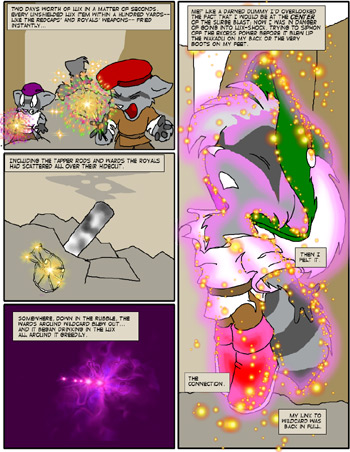
Click on the low-resolution sample page to see a 300K high-resolution version in a new window
Scott Bradfield is a Professor of English at the University of Connecticut. He has been writing sardonic short stories about interpersonal communications, or rather their failure, for a variety of literary magazines for almost twenty years. About half of them have featured intelligent animals—let’s say talking animals, since Bradfield’s surrealist characters, both animal and human, arguably display a maximum of self-centeredness and a minimum of intelligence. His 1995 novel Animal Planet is a parody of Orwell’s Animal Farm in which all animals are uplifted to human intelligence, ostensibly out of benevolence but actually to create a new bottom/labor class and more consumers for American capitalism. Bradfield’s latest collection, Hot Animal Love, is a good representation of his writing; thirteen short stories, of which seven feature animals. Call this book only half-anthropomorphic, then, but these seven stories are still worth seeking out.
in which all animals are uplifted to human intelligence, ostensibly out of benevolence but actually to create a new bottom/labor class and more consumers for American capitalism. Bradfield’s latest collection, Hot Animal Love, is a good representation of his writing; thirteen short stories, of which seven feature animals. Call this book only half-anthropomorphic, then, but these seven stories are still worth seeking out.
Angry Duck is told as a series of ‘tribute’ interviews with college professors, students, and similar intellectuals who knew avant-garde poet Sammy the Duck, after the latter’s tragic but mostly unlamented death.
“Sammy had won first place that year, already getting national coverage, and the best part? That kid knew how to handle a crowd. He’d waddle up to the mike with total self-control, huge with confidence, especially for a duck. This is me, his body language told you. I’m a fucking duck, and so what?” (pg. 4)
Sammy was not ideally suited for the halls of academe:
“Mainly he’d come to class totally sloshed, drinking something out of this chipped blue ceramic mug that said ‘Bawdy Bard’ on it, smelled like rotgut gin, swear to God. He kept falling off his desk, flapping like crazy, feathers everywhere. Then he’d read this crappy poetry he was writing, something about the universe, and we were all bound up in the metaphor, he called it a philosophical prose-poem or something, it didn’t make any sense at all.” (pgs. 6-7)
Judging by the samples of Sammy’s ‘angry’ poetry quoted, his favorite words were ‘quack’ and ‘fucking’. Guess how Sammy died.
Dazzle Redux is Bradfield’s second story featuring Dazzle, the talking dog. (The first, Dazzle, is in his 1990 collection, Dream of the Wolf.) Dazzle, now living as a feral dog in the mountains around Los Angeles with a complacent bitch and her pups, is happy; but could be happier if he would learn to just shut up!
“Maybe I’m not all I should be in the family skills department,” Dazzle confessed that night to his erstwhile mate, Edwina. “But getting through to those kids of yours is like having a conversation with a block of wood, I swear. If I try to instruct them in the most basic math and science skills, they’re not interested. If I try to teach them which way to look when crossing the street, they’re still not interested. If I try to point out the most obvious cultural contradictions of multinational capitalism, why, just forget about it. They’re really not interested. If you can’t eat it or fuck it, it’s not important; that’s their attitude.” (Etc., etc.; Edwina is sleeping through all this. pg. 31)
Finally despairing of trying to get his foster pups interested in geometry or Nietzsche or even not running with the local coyotes, Dazzle sets out to find his own father in the alleys and dumpsters of L.A.
Penguin for Lunch could be set in the world of Bradfield’s novel, Animal Planet. The penguins have all been civilized and educated, and now want to buy lots of consumer goods (“IT’S PENGUINIFIC!” blares an advertisement for Smirnoff’s vodka) and start corporations top-heavy with middle management. “The Ice Floe Bar and Grill belonged to a series of new upmarket franchise restaurants that had recently opened all across the tundra. As part of their inaugural promotion campaign, the Ice Floe was offering dollar margaritas during happy hour, along with all the free mackerel you could lay your flippers on.” (pgs. 45-46) Whistling Pete, a middle-aged exec at Consolidated Fish, begins to drink heavily, cheats on his wife with sexy penguinettes, and meets an unfortunate end despite the best efforts of his penguin buddy Buster to straighten him out.
In Doggy Love, my pick for the best story in the collection, dogs set up their own computer dating service using their masters’ computers when the humans aren’t looking. The story is in the form of numerous postings.
“I am a reasonably attractive mixed-breed setter and blond lab (on my mother’s side) seeking a companionable mate in the vicinity of Regent’s Park, where my master takes me most afternoons between four and five-thirty. I am three years old and, while still a virgin, my genitalia remain fully intact, which has led to some rather embarrassing confrontations with my master’s guests recently. Especially if they’ve been in contact with a female dog in the last, say, seven or eight hours.”
“It feels sad joining a computer dating service, but I’m a middle-aged bitch who has never been on a proper date in her entire life, so I’ve got to start somewhere. I should mention right off that I’m not a virgin. This is due to an unfortunate week spent in the so-called ‘animal-friendly’ Doggy-Do Kennels in West 14, when my mistress went to Barbados. It’s an experience I’d just as soon not talk about right now.” (pgs. 91-92)
The postings (mostly hilariously raunchy), which start out unconnected, develop into a story as two dogs, Randall and Denise, conspire (after Randall watches 101 Dalmatians on TV) to get their unmarried masters together through forged letters on a human singles Web site.
When a grown-up Goldilocks Tells All on an Oprah-like TV talk show, the Three Bears are pressured into responding. “I can’t stand it! I can’t stand it any more!” Baby Bear screamed from the summit of the stairs. He was wearing his sloppiest Varsity sweat suit and a pair of buzzing stereo headphones. As he pounded the floorboards with his hairy adolescent feet, lamps toppled from tables, and windows rattled in frames. “All I ever hear about is you you you!” Baby Bear cried. “But what about my feelings? Why doesn’t anybody stop for a minute to think about me?” (pg. 108)
In Dazzle’s Inferno, Dazzle the Dog becomes the unwilling subject of UCLA’s “recently endowed Department of Animal Linguistics”. The fact that he can already talk (won’t shut up, even) does not deter the staff from running Dazzle through their preconceived, scientifically planned Frankensteinian experimentations. “His eyes were sewn open; his paws were bound in see-through plastic tape; and an array of multicolored, follicular implants sprouted from his forehead like a cybernetic toupé.” (pg. 145)
Pig Paradise returns to the world of forcibly civilized animals. Hubert Armstrong the pig and Harry the Wolf share an office at Mama O’Brian’s All-Veggie Pies, a major corporation in a society of animal equality since the passage of the Cultural Intercession laws. But although Harry has never been anything but friendly (and their wives Angela/pig and Muriel/wolf are best friends), Hubie is too nervous around a wolf to work efficiently. So he files an interspecies harassment complaint with Employee Relations and, well, things escalate out of control from there.
Those are the seven animal stories. You will not be surprised that the humans (and angels and devils) in the remaining six stories are just as dysfunctional. (In fact, in Bradfield’s Heaven Sent and The Devil Disinvests, it is hard to see much difference between Heaven and Hell.) Doggy Love alone is worth getting the book to read—although, since Bradfield writes Literature, there is a good chance that you can find Hot Animal Love at your local public library instead of having to buy it.
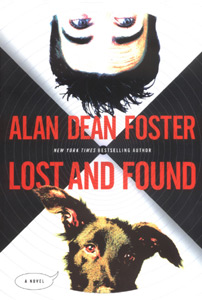 |
|
|
|
| Title: |
Lost and Found |
| Author: |
Alan Dean Foster |
| Publisher: |
Del Rey/Ballantine Books (New York, NY), Jul 2004 |
| ISBN: |
0-345-46125-8 |
|
|
Hardcover, 248 pages, USD $23.95 |
|
|
|
|
|
|
|
|
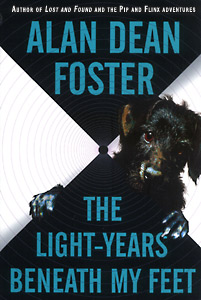 |
|
|
|
|
|
|
|
| Title: |
The Light-Years Beneath My Feet |
| Author: |
Alan Dean Foster |
| Publisher: |
Del Rey/Ballantine Books (New York, NY), Jun 2005 |
| ISBN: |
0-345-46128-2 |
|
Hardcover, 245 pages, USD $23.95 |
|
|
|
|
|
|
|
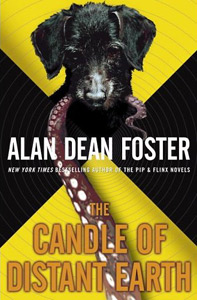 |
|
|
|
|
|
|
|
|
| Title: |
The Candle of Distant Earth |
| Author: |
Alan Dean Foster |
| Publisher: |
Del Rey/Ballantine Books (New York, NY), Jun 2006 |
| ISBN: |
0-345-46131-2 |
|
|
Hardcover, 262 pages, USD $23.95 |
|
|
|
|
|
|
|
|
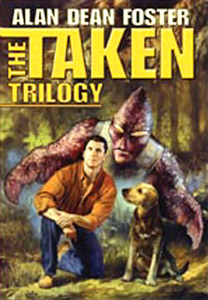 |
|
|
|
|
|
|
|
| Title: |
The Taken Trilogy |
| Author: |
Alan Dean Foster |
| Publisher: |
Science Fiction Book Club (New York, NY), Jun 2006 |
| SFBC code: |
482155 |
|
Hardcover, 640 pages, USD $14.99 to members only |
|
|
|
Alan Dean Foster’s three The Taken novels have been published a year apart from 2004 to 2006. I said of the first, Lost and Found, in Claw & Quill in October 2004: “Whether it is anthropomorphic depends upon how you feel about the characters in Pixar's Monsters, Inc. Lost and Found is light space opera about a single human thrown into a galactic civilization whose denizens look and act more like Sulley, Mike, Randall, Celia and the other no-two-alike inhabitants of Monstropolis than plausible interstellar life-forms.
“Marcus Walker, a young Chicago business executive, is abducted by space aliens. The villainous Vilenjji are a cross between galactic slavers and zoo suppliers. They flit from solar system to solar system to capture specimens of their intelligent life. They are mostly interested in breeding pairs, but not always. The two they pick from Earth are Marc and a dog, a shaggy alley mongrel.
“George the sardonic mutt is definitely a Furry character, thanks to a brain-boost by the Vilenjji so he can associate with the other captives. […] The actual reason is just a plot device to create a spaceship full of ultimate Odd Couples. […] There are many aliens described in colorful detail. The common factor is that they are all spectacularly different but able to live in the same environment and, thanks to the Vilenjjis' brain-boosts, they are of equal intelligence and can understand each other.
“The two pertinent aliens are Sque, a bossy female cephalopod—where what at first glance appeared to be a bright red octopus seemed to be reading a large, self-illuminated picture book (pg. 72)—whose personality is very similar to Monsters, Inc.’s Roz; and Braouk, a murderous but poetry-loving nine-foot-tall yellow-green furry mound. When Marc and George get tired of the boring prison-yard existence, Sque and Braouk are the only two fellow-captives who join them on breaking out of their big cage. They escape into the huge spaceship, where they play cat-&-mouse for weeks with the Vilenjji hunting parties while they search for a way to return to their respective home worlds. Since Lost and Found is the first volume of a trilogy, it is not giving away much to reveal that they do not get far yet.
“George will be the favorite character for Furry readers. His new intelligence does not change his basic doggy nature and high spirits.”
Now that all three novels are out, the trilogy can be reviewed as a whole. The main cast in Lost and Found are a human, a sarcastic large shaggy dog, an arrogant scarlet octopus, and a hulking poetic greenish furry haystack; plus Pret-Klob, the leader of the evil Vilenjji (“flap-armed purplish giants”); and various “tripodal, three-eyed, triple-armed, beige-tinted Sessrimathe, elegantly and colorfully clad”, (Light-Years, pg. 17) the members of the interstellar civilization who capture the Vilenjji slave-ship and liberate its prisoners. Unfortunately, the Sessrimathe cannot find any records in the Vilenjji ship of where in the galaxy Earth, K’erem (Sque’s homeworld), or Tuuqalia (Braouk’s planet) are, so the quartet become involuntary guests on their rescuers’ super-advanced homeworld.
The Light-Years Beneath My Feet has the annoying flaw typical of middle volumes of trilogies; a sense of marking time while little of importance happens. Marc gets bored in the luxurious idleness, and builds upon his old hobby of cooking to become a gourmet chef for the Sessramathe. This brings him unexpected popularity as a culinary artiste, and a meeting with a new alien, a Niyyuu.
To quote Foster’s description of the Niyyuu in full as an example of his extensive word-pictures of his aliens, which are otherwise abbreviated here, they are:
…unusually tall, unusually slender, and, it had to be admitted, unusually beautiful.
With a sinuous, graceful gait that bordered on the sensuous, the alien approached on a pair of long legs half hidden, half revealed by a boldly patterned kilt or skirt. The upper portion of the body was equally exposed by a covering of furry straps that crisscrossed the proportionately narrower torso. Protected by smaller straps, both arms ended in dual opposing digits. The head was equally long and slim, equine more than feline but with several features that tended toward the piscine. Slender ears a foot long emerged from either side of the hairless skull to extend stiffly upward. Though six foot four or so (notably taller if one included the ears), the creature weighed considerably less than he [Marc] did. Not one but four tapering tails emerged from a point below the back of the creature’s waist. They wove and twisted gracefully in and about one another like a quartet of cobras engaged in animated conversation.
Saucer-sized eyes, big and round as those of a tarsier, with massive golden pupils set against a pale yellow background, focused intently on him Set below a slightly protruding shelf of sculpted bone that might or might not conceal nostrils, the small mouth was open as if in a perpetual ‘O’ of surprise. He could not discern any teeth. A circular ring of pale muscle that encircled the mouth was stained with several bright colors. The effect was not unlike looking directly down at Saturn’s north pole from above.
The creature’s skin was smooth as silk. In the ambient light of the room it took on the hue of polished bronze. Walker could not tell if it was leathery, scalelike, or something previously unencountered. All he knew was that the effect was eye-catchingly attractive. (pgs. 20-21)
This Niyyuu, Viyv-pym-parr, offers him a prestigious position as chef in the palace of Kojn-umm on her planet. Marc accepts on the condition that his three companions be included, and that the Niyyuu agree to help them find their lost homeworlds. But Kojn-umm turns out to be one of several independent nations. After several adventures both political and military, Marc and his friends realize that they are being treated as prestige prizes by the rival governments. As one scientist finally admits:
“Yous four all unique individuals. No others like you on Niyu, ever. No others like you on Seramathenn, or anywhere else scientific establishment can determine. Your presence here a special thing for Niyu. Extraspecial for Kojn-umm. Pride involved. Pride and logic frequently mutually exclusive occurrences. Besides, you extraordinary food preparator.” (pg. 95)
The four ultimately figure out a scheme to force the Niyyuu to keep their promise. Light-Years ends with them boarding a united Niyu scientific expedition of three starships to find their respective planets, with the threat of Pret-Klob reappearing with more purple Vilenjji henchmen to follow in pursuit to “repossess their escaped property”. The Candle of Distant Earth introduces two more alien peoples; the pacifistic Hyfft, who look rather like short rabbity bear cubs—The face of the younger male bristled with brown and whit fur that had not yet begun to curl downward. Whiskers half the length of Ussakk’s stuck straight out to the sides of his short muzzle, stiff as needles. He was breathing hard in the short, quick gasps of his kind […] He puffed out his cheeks, a nervous gesture that inflated the lower half of his face to twice normal size. (pgs. 20-21)—and their enemies, the aggressive Iollth who taper like upside-down turnips from tiny heads filled with sharp teeth to huge lower bodies with big feet. The four companions and their Niyyuu shipmates settle peace between the Hyfft and Iollth as they quest, amidst many galactic marvels but little drama, for their homeworlds and the inevitable final confrontation with the Vilenjji.
The full trilogy does not change my recommendation two years ago: If your taste in anthropomorphic characters runs toward the exotically-bodied but mundanely-behaving cast of Pixar’s Monsters, Inc.—if what you like best about the Star Wars movies are the aliens like the Wookies, the Gungans, the Hutts, and whatever Yoda is—then you should enjoy Foster’s three Taken novels.
Simultaneously with Del Rey’s publication of The Candle of Distant Earth, the Science Fiction Book Club published a single-volume collection of all three novels. The Taken Trilogy is only $14.99, less than one volume of the general edition; but you have to be a member of the SFBC to get it.
This is the third prose novelette in Melville’s Felicia, Sorceress of Katara series published as a mini-book through CaféPress. The first two, still available, are Felicia and the Dreaded Book of Un, February 2004 and Felicia and the Tailcutter’s Curse, June 2004. The latter won that year’s Ursa Major Award in the Short Fiction category.
Felicia cla di Burrows, the vixen renegade sorceress expelled from the Magi Councils, first appeared as an enigmatic background character when Melville began self-publishing his Champion of Katara comic book in 1986. Spiteful and egocentric, all that was really clear was that Felicia had been horribly mistreated as a child, and she was studying sorcery—including forbidden black magic—to gain revenge against those who had destroyed her family. But her heart was not really in being evil, and she kept using her magic to help others while postponing her vendetta against her family’s enemies. As a flawed ‘good guy’, Felicia became the most popular of Melville’s Kataran cast as he moved his comic-book stories to MU Press. Felicia’s most dramatic and complex adventure was the 184-page graphic novel Felicia: Melari’s Wish (August 1994). Later in the ’90s, she starred in three lighter stand-alone stories as a sorceress-for-hire without the dark background of her vengeance goal, written by Melville and drawn by Bill Schmickle, in MU’s anthology comic-book ZU.
(August 1994). Later in the ’90s, she starred in three lighter stand-alone stories as a sorceress-for-hire without the dark background of her vengeance goal, written by Melville and drawn by Bill Schmickle, in MU’s anthology comic-book ZU.
Beginning in 2004, Melville has brought Felicia back in a series of text novelette booklets, with illustrations every few pages. These continue the lighter stories in ZU. Felicia is a sorceress-for-hire/detective who becomes involved with finding and dispelling ancient evils, or preventing their escape to wreak havoc in Katara and its neighboring animal kingdoms.
Felicia and the Wrath of the Elder Glops is the latest of these, and frankly is the slightest. It is the shortest at barely 50 pages (versus around 80 and 90 pages), and is the most blatantly humorous (or not entirely serious) with blurbs like, ‘Something Jiggly This Way Comes!’
Lord Edmund Titepahkets, a Lord High Solicitor from the raccoon Kingdom of Ra Kuna, hires Felicia “…on official business, milady, on behalf of the Royal Rakunian Judicial System… and on my own personal business. Both of these are related.” (pg. 15) A few hundred years earlier, one of Lord Titepahkets’ “…great-great-grandfather[s] was a High Administrator of one of the Lesser Hoards [of treasure] built and maintained on our family grounds, and he was considerably paranoid about the possibility of thieves.” (pg. 22) He engaged a Rakunian wizard to create a demonic guardian to protect the estate. Something went wrong, and the unknown guardian began to slaughter everyone in the mansion. The estate was hastily abandoned, and has been a deadly haunted ruin ever since. Recently one of Lord Titepahkets’ senior accountants disappeared, and an investigation revealed that he apparently found a clue to the Lesser Hoard hidden in the old Treasury ruins. Lord Titepahkets is afraid both that ‘Sticky’ Fingers will steal the Hoard, which still belongs to the Rakunian government, and that he may accidentally release the guardian to spread its devastation throughout Ra Kuna.
And so the fox sorceress and the portly raccoon bureaucrat go off to the ruined manor to find that, no surprise, ‘Sticky’ Fingers had broken in shortly before them and has aroused the deadly supernatural monster from its hibernation. Since Lord Titepahkets’ ancestor had wanted a guardian for a working Treasury office, he had instructed the wizard to create something that would be pleasant to be around; “Something powerful and deadly, yet fun and cheery.” (pg. 30) They find that they are just in time to forestall a plague of monsters:
Felicia did not reply, but continued to climb until they had both reached the next landing. She then turned and waved a hand out over the floor below.
Witchfire blazed and shot out like a comet and hung suspended high in the air, bathing the proximity in bright white light that quickly died away. And on the floor below, several brightly colored somethings slunk away back to the shadows.
“Did you see them?” she asked him grimly.
The raccoon nodded. “Yes! They were all so bright, like the one I saw earlier! Lemon yellow! Raspberry red! Orange orange! What… were they?”
“What I’d feared. It’s begun to spawn.” She continued the march upward into the darkest chambers of fear.” (pgs. 38-39)
CaféPress’ blurb describes Felicia as “…facing off against a monster from a forgotten Lovecraftian age…” The story is closer to the tradition of the popular World War I-era occult detectives like Algernon Blackwood’s John Silence, Dion Fortune’s Dr. Taverner, or William Hope Hodgson’s Carnacki, the Ghost Finder. But The Wrath of the Elder Glops is barely more than a skeleton of the occult detective formula: Felicia is informed of a ‘cursed’ building; she goes there to investigate; she immediately finds the demonic monster is real, and is attacked by it; and she quickly defeats/exorcises it. Period. There are almost none of the subplots or extra details that are in the other Felicia stories.
Felicia fans will enjoy Felicia and the Wrath of the Elder Glops. It has some new details about the Rakunian culture. For those not yet familiar with the vixen sorceress, Felicia and the Tailcutter’s Curse is a better story to start with. Actually the graphic novel, Felicia: Melari’s Wish, still available from MU Press, is the best starting place of all.
I was going to begin this review by quoting its opening, since Firmin the rat makes such a big deal of it. The problem is that it goes on and on and on at pretentious length. Here is Firmin’s second paragraph, which is marginally better:
In all my life struggling to write I have struggled with nothing so manfully—yes, that’s the word, manfully—as with openers. It has always seemed to me that if I could just get that bit right all the rest would follow automatically. I thought of that first sentence as a kind of semantic womb stuffed with the busy embryos of unwritten pages, brilliant little nuggets of genius practically panting to be born. From that grand vessel the entire story would, so to speak, ooze forth! What a delusion! (pg. 1) Oops! Turning the page, I see that this paragraph goes on, too, to fill half of page 2 before rambling to a stop. This is just its first half.
Could you guess that Firmin grew up in a nest made from chewed-up pages of Finnegan’s Wake, Don Quixote, and Moby Dick, three of the longest and densest novels in literature? Sure, you could.
Firmin will probably be more meaningful to readers familiar with Boston and its history. Scollay Square was Boston’s financial and social center for most of the 19th century. By the mid-20th century it had become an all-too-common decaying inner city, until in a major renovation development in the early 1960s it was entirely razed and replaced by soulless modern office buildings.
Firmin is the reminiscences of a rat born during the last days of the old Scollay Square, in the basement of a used bookshop surrounded by bars and strip joints. Pembroke Books is packed with thousands of old books. Its basement is relegated to those that nobody wants, so nobody notices that rats have been nesting there for generations. Firmin is the 13th rat, and the runt, in his litter. As those familiar with rats know, mother rats have only twelve teats. Firmin is the one who usually goes unfed—a mixed blessing since Mama Flo usually comes home so tipsy from lapping up spilled beer in the alleys that her milk is alcoholic enough to turn his brothers and sisters into juvenile drunkards. Firmin on childhood memories:
When I think of Mama at this point nothing enters my mind but words. I screw my concentration up to the point where I am almost fainting, and still nothing is there but a blurred shape and the words not enough tits—that, and a thick sawdust-and-beer fragrance like a saloon floor. (pg. 13)
Firmin survives by eating the paper in his family nest, which leads him to the stacks of old books around him. Gradually he progresses to reading the books, digesting the words intellectually more than for the nourishment he derives from the paper: Kant, Engel, Swedenborg, Ezra Pound. This leads to an abnormal physical development of his mind and skull:
The combination of a heavy head and weak limbs forced me to adopt a ponderous gait, and while later in life I fancied that this lent me a methodical and dignified air, at the time it only made me seem all the more freakish. I could not help wagging my enormous head from side to side as I walked, or lumbered, which gave me a rather bovine appearance. And front-loaded as I was, I had a strong tendency to pitch forward onto my face, to the great amusement of others. (pg. 26)
Firmin’s world centers around Pembroke Books and the neighboring Rialto Theater. At the bookshop he develops a secret passion for its proprietor, Norman Shine:
On Saturday afternoons, especially when the weather was fine, the shop would be crowded with customers, and Norman would leave his desk by the door and move about the store helping people find what they wanted. He was beautiful then, moving gracefully among them. He was like a musketeer. He was Athos, quiet and reserved, slow to anger, but deadly when provoked. Assaulted by a question from behind, he spins about, thrusts his rapier at a top shelf, and draws down, impaled and flashing like a fish on a spear, Death in Venice. Another request might send him charging down an aisle, a turn at the corner of a shelf, a left feint in the direction of juvenilia, and then, crouching, a lunge to the right—and there, skewered by his sword point, is Betty Crocker’s Picture Cook Book. (pg. 47)
At the Rialto, a combination 24-hour movie theater and flophouse, Firmin discovers the treasures of classic cinema along with its popcorn-strewn floors: Charlie Chan, Gene Autry Westerns, Abbott and Costello, ’30s gangster movies, porno movies after midnight—but above all the brilliant sophistication of Fred Astaire and Ginger Rogers.
While reveling between these temples of culture, Firmin becomes aware of Norman’s growing worries over newspaper articles about Boston’s plans to renovate their ‘blighted’ neighborhood by completely demolishing it. He also learns that a frequent customer, Jerry Magoon, a mentally-disturbed old man who lives in the cheap rooming house above the bookshop, once wrote a science-fiction novel in which well-meaning aliens kill all life on Earth except the rats.
Firmin considers trying to cheer Norman up:
But what I really wanted to do, what in fact I almost did, was to rush out of the Rathole, throw myself at his feet, and madly kiss his shoe. He would be deeply touched. He would take me with him when he moved. It is interesting the way illusions have no end. What would Norman really think if a rat rushed from behind a safe and attached itself to his shoe? In the real world there are differences that cannot be bridged. (pg. 73)
What Norman really does once he becomes aware of Firmin is to set out rat poison. Disillusioned and embittered, Firmin allows himself to be adopted as a pet by Jerry Maguire. Jerry is so spaced out that he sees nothing unusual in Firmin’s reading the books on his floors or playing the child’s toy piano he salvages from the trash:
I loved that piano, and he knew it and never did give it away. I played mostly Cole Porter and Gershwin. And sitting on the bench, swaying to the music, I looked exactly like Fred Astaire, and I sang like him too. Sure, I know that this was true only from a certain perspective, and that all Jerry heard was a high ratlike squeak. But he loved it just the same. The first time I played and sang for him he laughed till tears ran down his cheeks. I would have preferred something other than laughter, but I did not really mind. (pgs. 95-96)
Firmin stays with Jerry for several months, until the old man has a stroke. After that, the end is swift. Their block is condemned and the bookstore and movie theater are forced to close. Even the younger rats move out as the heavy earthmoving machinery and wrecking balls approaches their building, but Firmin, now elderly as rats go (the life span of the average rat is only one year), cannot bring himself to abandon his lifelong home.
Firmin is an anthropomorphic novel that can be read on two levels. Most obviously, it is the autobiography of an intellectual rat. More metaphysically, in Firmin the author has created an intelligent persona for the old Scollay Square itself in its last days: blighted and derelict, maybe, but a unique personality still full of life and kicking right up to the last moment. Yes, but on both levels Firmin is unrelievedly despondent. The publisher is Coffee House Press, and it is easy to imagine this tale being told at a coffee house by an old homeless person who staggers up to your table and won’t go away. Buy according to your tastes for intellectual stimulation.
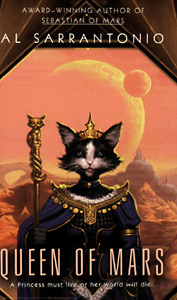 |
|
|
|
| Title: |
Queen of Mars |
| Author: |
Al Sarrantonio |
| Publisher: |
Ace Books (New York, NY), Jun 2006 |
| ISBN: |
0-441-01411-9 |
|
|
Paperback, 232 pages, USD $6.99 |
|
|
|
|
|
|
|
|
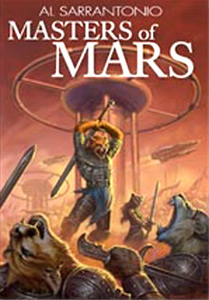 |
|
|
|
|
|
|
|
| Title: |
Masters of Mars |
| Author: |
Al Sarrantonio |
| Publisher: |
Science Fiction Book Club (New York, NY), Jun 2006 |
| SFBC code: |
209610 |
|
Hardcover, 536 pages, USD $14.99 to members only |
|
|
|
Queen of Mars completes the trilogy begun with Haydn of Mars and Sebastian of Mars (reviewed in Anthro #4). If you liked those, you should enjoy this conclusion—unless you feel it is too much of the same. If you have not started the trilogy yet and want to read all three novels, there is a one-volume collection, Masters of Mars, from the Science Fiction Book Club.
Sarrantonio’s Mars trilogy is an old-fashioned fantasy in the style of Edgar Rice Burroughs’ tales of Barsoom, rather than plausible science fiction. His Mars is populated with anthropomorphized cats whose politics, with battles between Republics and Empires, are more like those in Star Wars. The protagonist is young Princess/Queen Clara, daughter of Sebastian and granddaughter of Haydn, who must lead the struggle to establish the democratic Republic that her predecessors were murdered on the verge of bringing about.
Clara, when introduced, seems younger and more spoiled than either of them:
I turned to glare at her, but her warm smile remained. “You are a wonderful young feline, Clara, but you are far too serious and far too young to be so. Your father was too young to assume the crown when he as forced to do so, and he was two years older than you. In many ways, you are still a kit—”
“Don’t use that word!” I shouted, stamping my foot. I stopped in the corridor, and those behind us, old Newton and Thomas and a few others, halted also. I was infuriated by the smug look of tolerance on all their faces. (pg. 4)
Nevertheless, Clara is assured by Newton, the ancient head of the Science Guild:
“But I tell you this, and listen to me. You have in you qualities that are greater than either your grandmother Haydn, who was impetuous and headstrong, or your father Sebastian, who was, in the end, rash and too daring. You have a more solid head on your shoulders than either of them—and they were great felines.” (pg. 6)
When the fragile Second Republic’s old enemy, Frane of the powerful F’rar clan, returns from the dead to make a third attempt to conquer the planet, Clara, as the newly-crowned Queen of the Republic, becomes the figurehead leader of its army to lead it into battle:
When I appeared, there was a stiffening of backs and a hush. I rode slowly, inspecting the troops, nodding regally and keeping a steady pace. I had no idea what I was doing, but tried to remember Xarr’s advice: ‘Look like you know what you’re doing, and you’ve already done it.’ I hoped that my light crimson tunic, thinly fringed in a light shade of gold, was appropriate. The matching cape wafted behind me in the gentle breeze, and my sword, in its plain, lighter scabbard, felt good against my side. (pg. 43)
Anthro’s previous review said of the middle novel:
“Sebastian of Mars is set five years later; an entire generation among the cats. […] Sebastian, Haydn’s son and heir, has just reached his majority and is about to be crowned when the fragile peace established by Haydn breaks down […] Sebastian spends even more of the novel than Haydn did in hers disguised and on the run, in new areas of Mars.”
Change ‘Sebastian’ to ‘Queen’, and that is pretty much a summary of Queen of Mars as well. Sarrantonio tries to be clever about the imitations:
“But, Grandmother, the F’rar have been loyal for more than five years! My mother is F’rar, and I am half-F’rar! Frane could not wrest them from the Republic a third time!” (pg. 8)
Despite being on guard against what Frane did twice before, there are plausible reasons for the Republic’s political and military leaders falling for similar tricks, forcing Clara (who knows better, but she is so young that nobody listens to her) to escape into an exile similar to her grandmother’s and her father’s. There are subtle differences in each case that turn out to be important. Sarrantonio may be trying to set up the reader to expect too close a copy of the first two novels, only to spring a surprise by the differences. If so, it is a literary trick that mostly fails. The differences are too slight to avoid the repetitions creating a feeling of, ‘been here, read that before.’
This concluding novel does answer the mysteries from the first two books. The terraforming process is rediscovered just in time to save Mars’ atmosphere (like this was ever in doubt!), and the feline Martians learn who the Old Ones really were. Yet another feline race is introduced; the desert-dwelling Sandies. There is plenty in Queen of Mars to satisfy readers who want lots of descriptions of bipedal cats in colorful costumes. And while it will help to have read the first two books, Queen of Mars stands nicely on its own, so those who have not read the previous volumes are not forced to read them first.
But readers will have to overlook the fact that it is even more obvious in Queen of Mars that the felinicity (to coin a word) is just superficial window dressing. We learn that the cats have acquired their intelligence, their upright stance, and their semi-human size as the result of one and three-quarters million years of evolution on Mars since the Old Ones abandoned the planet; but horses and dogs are unchanged. (The concept of cats with pet dogs is amusing.) The descriptions of the intelligent cats as midway in size between ancient cats and humans is too often ignored; how easily could characters that small ride on horseback? ‘Fur’ is mentioned a lot but too often in descriptions indistinguishable from human naked skin:
His light brown fur blanched, and his eyes widened. (pg. 198)
Queen of Mars, and the whole trilogy, is light fun but not essential reading for Furry libraries.
Anthropomorphic books for review should be sent to Fred Patten, at:
Golden State Colonial Convalescent Hospital, 10830 Oxnard Street, North Hollywood, CA, 91606



